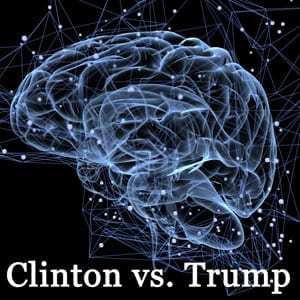 Why does Donald Trump do well in the post-debate analysis when he doesn’t answer questions, repeatedly goes off topic, and refers to things that are incorrect or irrelevant? Why doesn’t Hillary Clinton emerge with a clear advantage when she answers questions, is fairly accurate and, for the most part, stays on point and doesn’t get too nasty? The answer lies in the reptilian brain—the part of the brain that filters messaging. The messages that stick are those that trigger instinct and emotion.
Why does Donald Trump do well in the post-debate analysis when he doesn’t answer questions, repeatedly goes off topic, and refers to things that are incorrect or irrelevant? Why doesn’t Hillary Clinton emerge with a clear advantage when she answers questions, is fairly accurate and, for the most part, stays on point and doesn’t get too nasty? The answer lies in the reptilian brain—the part of the brain that filters messaging. The messages that stick are those that trigger instinct and emotion.
The Economist ran a cartoon a couple of weeks ago that summed it up for me. The cartoon had Clinton explaining how something needed careful analysis and thoughtful consideration. I don’t remember the words. Trump’s bubble said “Loser.” And that’s what I remember.
The winner of a debate is the one who paints the most pictures that make us feel something, independent of context or reason. The key is HOW they message, not WHAT they say. I’m not talking politics, except insofar as this impacts voting results. I’m not picking sides. I’m talking about the way our brains work.
When you talk to someone with pictures, it engages their instincts, emotions, and memories. If your messages are only words that don’t make pictures, the rational brain has to decode them to see what they mean. Our brains are lazy and that’s a lot of work. The more image and emotion, the more attention the brain allocates—the more it cares and the more YOU care. Images and emotion influence how we make meaning of words. If we are afraid, we look for security. We don’t debate the truthfulness, we cognitively circle the wagons. Whether through knowledge, experience or luck, Trump gets this and Clinton largely does not.
Whether you like it or not, Trump is just a better picture painter. He makes pictures that trigger emotion. Even if you don’t agree with what he’s saying or even if what he’s saying has nothing to do with the question at hand, he paints an image that sticks—most often one that is a threat to the listener’s existence. Trump lays the blame for the fear and uncertainty on Clinton or elsewhere. It makes no sense, of course, but our brain doesn’t care; it is scared and wants to feel safe again. Trump doesn’t even have to say he’s the answer.
The inner workings of the human brain and the neural processing that result in our thoughts, feelings and actions are complex. People have used various models to simplify it so we can better understand why we do the things we do. For example, you’ve probably heard of people being right brain (creative, image-oriented) or left brain (linear, fact-oriented). Kahneman (2011) made dual processing famous describing the difference between fast thinking behaviors and slow thinking that increases the demand for conscious attention. Neuroscientist MacLean (1990) proposed that we had three-brains-in-one (the tripartite brain theory) made up of conscious thought in the new, rational brain, and unconscious reactions in the emotional brain and the reptilian instinctive brain. This Triune Brain, in particular, provides a good rule of thumb for how to get a message heard. Information comes into the brain through our senses. It is first processed by instinct (the reptilian brain) and emotions—speaking the language of feelings and images.
When the debate moderators raised the question of sexual assault raised by a 2005 videotape showing Trump bragging about accosting women, Trump responded by talking about the dangers of ISIS. This was either irrelevant or the same as saying that lewd “locker room” talk was not a serious problem in the face of “real” problems. But our brains don’t ponder these intellectual implications. Our brains make the pictures of ISIS brutalities that Trump described: slit throats, mass bombings in Paris, and drowning people in cages. Thus he left people revisiting the horrors of ISIS—which have nothing to do with such vulgar proof of his sexist perspectives.
Clinton, in response, said that this video shows what Trump is like. What does that mean? Clinton gave away a huge reptilian-brain opportunity to paint that picture of a man who forces himself on you, your wife, your sister, or your friend, a man who condones saying lewd things about women because it’s locker room talk, or a man who thinks that sexual assault—grabbing parts of a woman’s body without consent— doesn’t count as a “real problem.” It was clear that Clinton really didn’t understand the reptilian brain and the importance of communicating in imagery when she referred to Trump’s “demagoguery” a word even fewer people will understand than “deplorable.”
 Elections are about emotions. It’s about people who feel angry and scared and who want someone to blame. Trump continually pulls that trigger. He paints that image using words and physical space. While Clinton is articulate, poised and thoughtful, Trump looms, crowds her personal space, and tries to physically dominate the camera. He uses ISIS, he uses lost jobs, he uses Bernie Sanders to reengage the anti-Clinton emotions that Sanders created and he offers up the “establishment” as the cause of all this evil. Clinton is walking a delicate line, as gender is an issue in the lens people use to view her comments. If she had been half as rude as Trump, she would have skewered in that unspoken double standard that allows rudeness in “forthright men” who tell it like it is as opposed to “bitchy women.” This is another really good reason for Clinton to paint some vivid pictures and let the voters “feel” the difference. As we learned in 3rd-grade language arts: she needs to show, not tell.
Elections are about emotions. It’s about people who feel angry and scared and who want someone to blame. Trump continually pulls that trigger. He paints that image using words and physical space. While Clinton is articulate, poised and thoughtful, Trump looms, crowds her personal space, and tries to physically dominate the camera. He uses ISIS, he uses lost jobs, he uses Bernie Sanders to reengage the anti-Clinton emotions that Sanders created and he offers up the “establishment” as the cause of all this evil. Clinton is walking a delicate line, as gender is an issue in the lens people use to view her comments. If she had been half as rude as Trump, she would have skewered in that unspoken double standard that allows rudeness in “forthright men” who tell it like it is as opposed to “bitchy women.” This is another really good reason for Clinton to paint some vivid pictures and let the voters “feel” the difference. As we learned in 3rd-grade language arts: she needs to show, not tell.
If you think this election defies all logic, pay attention to who speaks to the reptilian brain.
P.S. Ironically, it’s that same ability to “paint a visual picture” that may take Trump down. After the release of various videos and women coming forward with their experiences, is there anyone left without all-to-clear image of Trump forcing himself on women or peeking up models skirts? Whatever happened to the dignity of the office of President?
Kahneman, D. (2011). Thinking, Fast and Slow. New York: Farrar, Straus and Giroux.
MacLean, P. D. (1990). The Triune Brain in Evolution. New York: Plenum Press.

 Dr. Pamela Rutledge is available to reporters for comments on the psychological and social impact of media and technology on individuals, society, organizations and brands.
Dr. Pamela Rutledge is available to reporters for comments on the psychological and social impact of media and technology on individuals, society, organizations and brands.